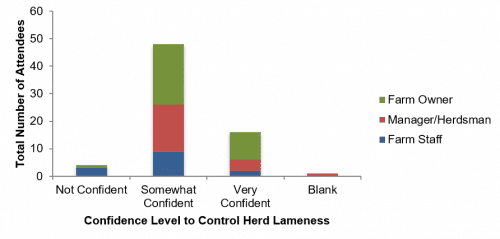In an ongoing attempt to support the dairy industry, Alberta initiated the Lameness Reduction Initiative (LRI). The LRI is an ongoing program with multiple components; one of the first was on-farm workshops to demonstrate the risk assessment process underlying the animal welfare component of proAction. Before the workshop started, 69 participating producers were surveyed to evaluate their knowledge and understanding on lameness in dairy cattle.
Part 1 of the survey focused on farming background and the producer’s perceived ability to control herd lameness. Approximately 80% of attendees were farm owners and managers, whereas the remainder were farm staff. Although most participants had at least 10 years’ experience working on a dairy farm, only 20% of respondents felt “very confident” in their ability to control lameness in their herd (Fig. 1). Of interest was that participants’ motivation to attend the workshop was “to learn and find strategies to mitigate lameness.”

The most useful information sources
Participants were asked to rank the most useful information sources to support them in identifying the best control strategies for lameness in their herds (Fig. 2). Hoof trimmers ranked highest as the most useful information source, followed by veterinarians and fellow producers. Moreover, some producers ranked veterinarians only as the fourth or fifth option, suggesting that dairy practitioners are not necessarily regarded as being able to adequately support producers with regards to lameness control issues.

Causes and risk factors of lameness
In the second part of the survey, attendees were asked to answer “true or false” questions to test their knowledge on lameness prevention. Most respondents answered a third of the questions and left the rest blank, presumably due to lack of time or uncertainty about the question at hand. Of the questions answered, on average 80% were answered correctly. These questions focused on common risk factors associated with lameness. Over 85% of respondents identified correctly that digital dermatitis (DD) was the most common lesion affecting Alberta dairy cattle and that hygiene was important in the occurrence of this hoof lesion.
Producers also identified the importance of locomotion scoring cattle to identify those that are lame. Other risk factors on farm such as hard surfaces and maintaining a healthy body condition were correctly identified by most of the respondents. Some misconceptions about causes and risk factors for lameness also surfaced, for example the ability to identify all DD affected cattle through signs of pain. Also, the role of hoof trimming was overestimated as being able to prevent DD in fresh cows. Many producers did not believe that presence of DD lesions can increase the risk of cattle becoming lame. This highlights the fact that lameness is a complex health issue and that not everybody understands knowledge guiding prevention and control measures.
The key to control lameness: education and effective communication
The LRI has used the information of this survey to assist in some priorities for future steps and to guide communication strategies. Although the industry, as mentioned in the Canadian Dairy Code of Practice, states a target of <10% of lameness score of 3 or more, on average we are still dealing with a 20% lameness score. Going forward, education, effective communication between dairy producers and both veterinarians and hoof trimmers will be important to prevent and control lameness as there are some misconceptions among producers when identifying lameness in a dairy herd. Furthermore, we encourage producers, especially owners and herd managers to broaden their knowledge on the topic and to continue seeking advice from their veterinarians and hoof trimmers. Consultants and experts in the field should try to identify more effective ways to put the knowledge in the hands of the producers to effectively control lameness on farm.
The Calgary lameness team will continue its endeavor combating lameness in cattle and contribute to the LRI initiative. We are hopeful that we will be able to expand to multiple provinces.
Source: Lactanet




